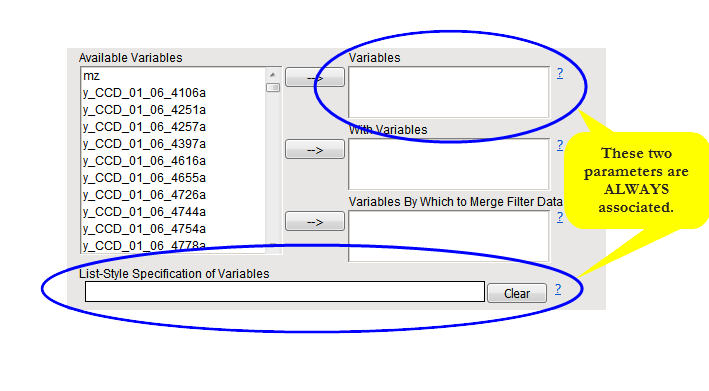This optional field allows you a convenient method to specify variables that are numbered sequentially or contain a common prefix when there are more than can be conveniently selected by highlighting the variables in the
Available Variables
field and using the
 button. A typical
List-Style Specification
field is shown below:
button. A typical
List-Style Specification
field is shown below:
All variables beginning with
var
will be specified.
|
|||||||||
|
For example, to specify all of the variables in your data set that begin with the prefix
var
and all of the variables that begin with the prefix
geno
,
Caution
: When specifying variables with different prefixes using the common prefix notation (
_:
) can change the order of variables in the output data. If you have more than one prefix for variables, be sure the order of the markers in the data set has been sorted by prefix to avoid unexpected results. If you are unsure of the order, you can specify the variables by position in the data set as described below. In this case, you reference the left-most and right-most variables
1
in the data set separated by a double hyphen. For example, if the first ordered variable in the data set is
var1
and the last is
geno500
, specify
var1--geno500
.
|
|||||||||
|
For example, suppose your data set contains 2500 variables,
var1
to
var2500
, and you want to specify the first 500 variables.
|
|||||||||
|
For example, suppose your data set contains 2500 variables,
var1
to
var2500
, and you want to specify
var101
,
var456
and
var1210
.
Type
var101 var456 var1210
in the text box. Separate each variable with a single space.
|
|||||||||
|
For example, suppose your data set contains 2500 variables,
var1
to
var2500
, and you want to specify
var1
,
var2400
and all of the variables between
var1210
and
var2150
.
Variables
var1
,
var2400
, and all of the variables between
var1210
and
var2150
, inclusively, will be selected
You can also specify these variables using both the
List-Style Specification
field and the associated variable field.
Note
: This method is especially useful when specifying variables with different prefixes.
|
|||||||||
|
For example, suppose your data set contains 5 variables,
A1
,
B2
,
C3
,
D18
and
F10
, and you want to specify
B2, C3
and
D18
.
|
|||||||||
|
For example, suppose your data set contains 2500 numeric variables,
var1
to
var2500
, and 5 character variables,
A1
,
B2
,
C3
,
D18
and
F10
, and you want to specify all of the numeric variables.
|
|||||||||
|
For example, suppose your data set contains 2500 numeric variables,
var1
to
var2500
, and 5 character variables,
A1
,
B2
,
C3
,
D18
and
F10
, and you want to specify only the numeric variables between
D18
and
F10
.
|
|||||||||
|
For example, suppose your data set contains 2500 numeric variables,
var1
to
var2500
, and 5 character variables,
A1
,
B2
,
C3
,
D18
and
F10
, and you want to specify all of the character variables.
|
|||||||||
|
For example, suppose your data set contains 2500 numeric variables,
var1
to
var2500
, and 5 character variables,
A1
,
B2
,
C3
,
D18
and
F10
, and you want to specify character variables located between
var1251
to
var2000
.
|
|||||||||
|
You can use the
Check Data Contents
process to determine the names and order of the variables in the data set.
Caution
: Using the common prefix notation (
_:
) could potentially include variables created by SAS procedures, in spite of your intention otherwise. Therefore, it is strongly recommended that you either avoid this notation, or specify the longest prefix possible before the colon to avoid capturing extraneous variables.
Note
: If you change your mind and would like to reset the field, click
.
